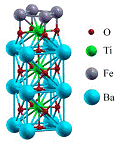Department of Physics and Astronomy: Publications and Other Research

Evgeny Tsymbal Publications
ORCID IDs
Tsymbal http://orcid.org/0000-0002-6728-5565
Document Type
Article
Date of this Version
7-20-2018
Citation
Physical Review B (2018) 98: 045129
doi: 10.1103/PhysRevB.98.045129
Abstract
Using density-functional theory calculations, we investigate the dominant defects formed by boron (B) and carbon (C) impurities in a CoFe/MgO/CoFe magnetic tunnel junction (MTJ) and their influence on conductivity and tunneling magnetoresistance (TMR). We find that, in the O-poor conditions relevant to experiment, B forms the substitutional defect BCo and C forms the interstitial site Ci at the CoFe/MgO interface. The C-doped MTJ is predicted to have a significantly higher TMR than the B-doped MTJ. This is due to interface state densities associated with the majority spin Δ1-symmetry bands being more heavily suppressed by the BCo defects than by the Ci defects. Our results indicate that carbon can serve as a viable alternative to boron as a dopant for MTJ fabrication.


Comments
Copyright 2018, American Physical Society. Used by permission